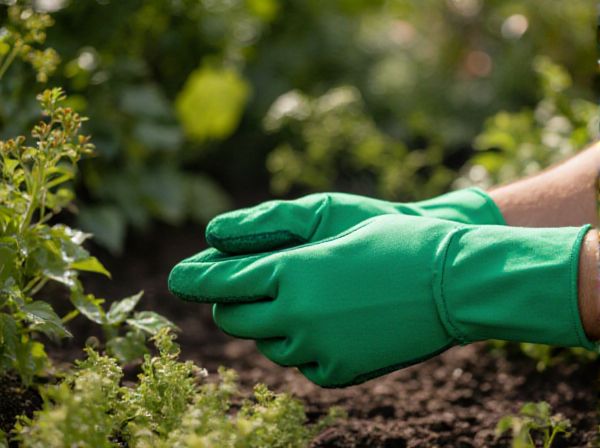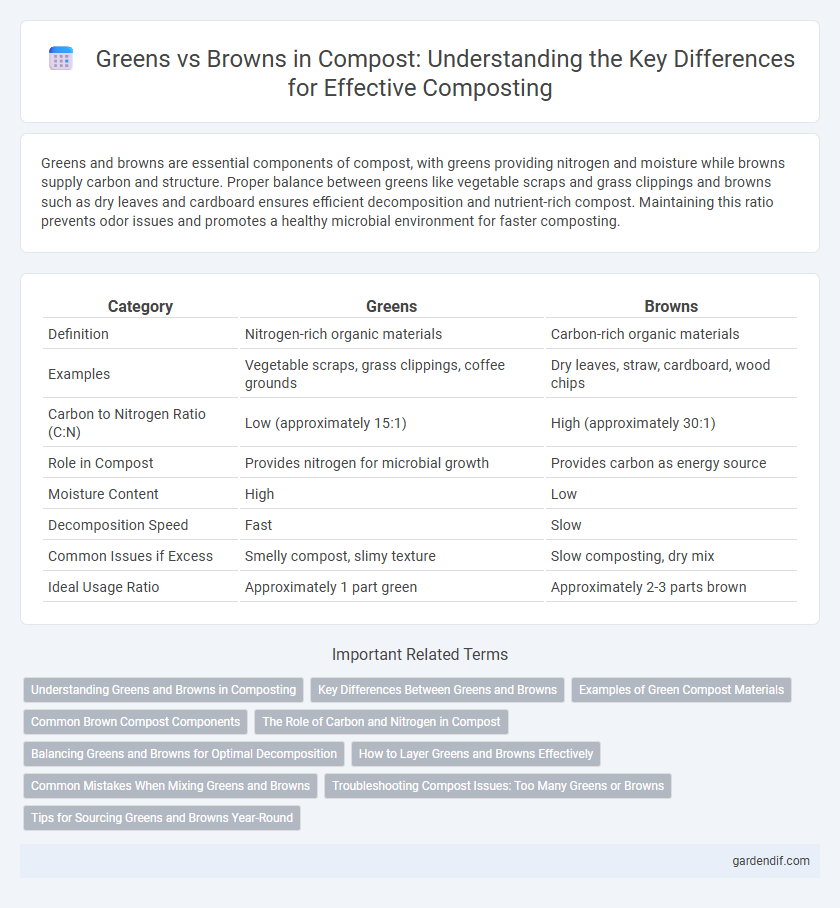
Greens vs Browns Illustration
Greens and browns are essential components of compost, with greens providing nitrogen and moisture while browns supply carbon and structure. Proper balance between greens like vegetable scraps and grass clippings and browns such as dry leaves and cardboard ensures efficient decomposition and nutrient-rich compost. Maintaining this ratio prevents odor issues and promotes a healthy microbial environment for faster composting.
Table of Comparison
| Category | Greens | Browns |
|---|---|---|
| Definition | Nitrogen-rich organic materials | Carbon-rich organic materials |
| Examples | Vegetable scraps, grass clippings, coffee grounds | Dry leaves, straw, cardboard, wood chips |
| Carbon to Nitrogen Ratio (C:N) | Low (approximately 15:1) | High (approximately 30:1) |
| Role in Compost | Provides nitrogen for microbial growth | Provides carbon as energy source |
| Moisture Content | High | Low |
| Decomposition Speed | Fast | Slow |
| Common Issues if Excess | Smelly compost, slimy texture | Slow composting, dry mix |
| Ideal Usage Ratio | Approximately 1 part green | Approximately 2-3 parts brown |
Understanding Greens and Browns in Composting
Greens in composting include nitrogen-rich materials such as vegetable scraps, coffee grounds, and fresh grass clippings that speed up decomposition. Browns consist of carbon-rich items like dried leaves, straw, and cardboard that provide structure and aeration for microbial activity. Proper balance between greens and browns, typically a carbon-to-nitrogen ratio of 30:1, ensures efficient breakdown and nutrient-rich compost.
Key Differences Between Greens and Browns
Greens in compost consist of nitrogen-rich materials like grass clippings, vegetable scraps, and coffee grounds that promote microbial activity and heat generation. Browns provide carbon, derived from dry leaves, straw, and cardboard, which balance moisture and aerate the compost pile. The ideal compost ratio balances greens and browns to accelerate decomposition and reduce odors effectively.
Examples of Green Compost Materials
Green compost materials primarily include nitrogen-rich items such as grass clippings, fruit and vegetable scraps, coffee grounds, and fresh garden trimmings. These materials accelerate decomposition by providing essential nitrogen that feeds the microbial activity in the compost pile. Proper balance with brown materials like dried leaves or straw ensures optimal composting efficiency.
Common Brown Compost Components
Common brown compost components include dry leaves, straw, wood chips, cardboard, and paper. These materials provide essential carbon that balances the nitrogen-rich green materials in compost, aiding microbial activity and structure. Properly incorporating browns ensures efficient decomposition and reduces odors in composting.
The Role of Carbon and Nitrogen in Compost
The balance of carbon-rich "browns" and nitrogen-rich "greens" is essential for effective composting, as carbon provides energy for microbes while nitrogen supports protein synthesis crucial for microbial growth. High carbon materials like dried leaves, straw, and cardboard promote aeration and structure, whereas nitrogen sources such as grass clippings, kitchen scraps, and coffee grounds accelerate decomposition through microbial activity. Maintaining an optimal carbon-to-nitrogen ratio, typically between 25:1 and 30:1, enhances nutrient cycling and results in nutrient-rich, well-decomposed compost.
Balancing Greens and Browns for Optimal Decomposition
Balancing greens and browns in compost is crucial for optimal decomposition, as greens provide nitrogen and browns supply carbon essential for microbial activity. An ideal carbon-to-nitrogen (C:N) ratio of approximately 30:1 accelerates the breakdown process, resulting in nutrient-rich compost. Excess greens can create a slimy, smelly pile, while too many browns slow down decomposition, highlighting the importance of maintaining the right balance.
How to Layer Greens and Browns Effectively
Effective compost layering involves alternating greens, rich in nitrogen like vegetable scraps and grass clippings, with browns, high in carbon such as dry leaves and straw. A recommended ratio is two to three parts browns to one part greens to maintain a balanced carbon-to-nitrogen ratio for optimal microbial activity. Proper layering enhances aeration and moisture retention, accelerating the decomposition process and producing nutrient-rich compost.
Common Mistakes When Mixing Greens and Browns
Using too many greens such as vegetable scraps or fresh grass clippings in compost can lead to a slimy, foul-smelling pile due to excess moisture and nitrogen. Overloading with browns like dry leaves and wood chips can slow decomposition because of insufficient nitrogen to fuel microbial activity. Balanced layering and proper ratios--typically 2 to 3 parts browns to 1 part greens--are essential for efficient composting and odor control.
Troubleshooting Compost Issues: Too Many Greens or Browns
Balancing greens and browns is crucial for effective composting, as too many greens (nitrogen-rich materials) can cause unpleasant odors and a soggy compost pile, while excess browns (carbon-rich materials) slow down decomposition and create a dry, crumbly texture. To troubleshoot, add dry browns like leaves, straw, or shredded paper to absorb moisture and restore aeration when the pile smells ammonia or becomes slimy. Conversely, incorporate more greens such as grass clippings or kitchen scraps if the compost decomposes too slowly or appears dry, ensuring optimal microbial activity and efficient breakdown.
Tips for Sourcing Greens and Browns Year-Round
Sourcing greens year-round involves collecting fresh kitchen scraps, grass clippings, and garden trimmings rich in nitrogen, essential for accelerating decomposition in compost. Browns, high in carbon, can be sourced consistently from fallen leaves, straw, shredded cardboard, and paper, ensuring a balanced compost mix that heats properly and breaks down efficiently. Storing surplus browns in dry, ventilated containers and freezing seasonal greens like vegetable peels preserves materials for continuous composting through different seasons.
Greens vs Browns Infographic

 gardendif.com
gardendif.com